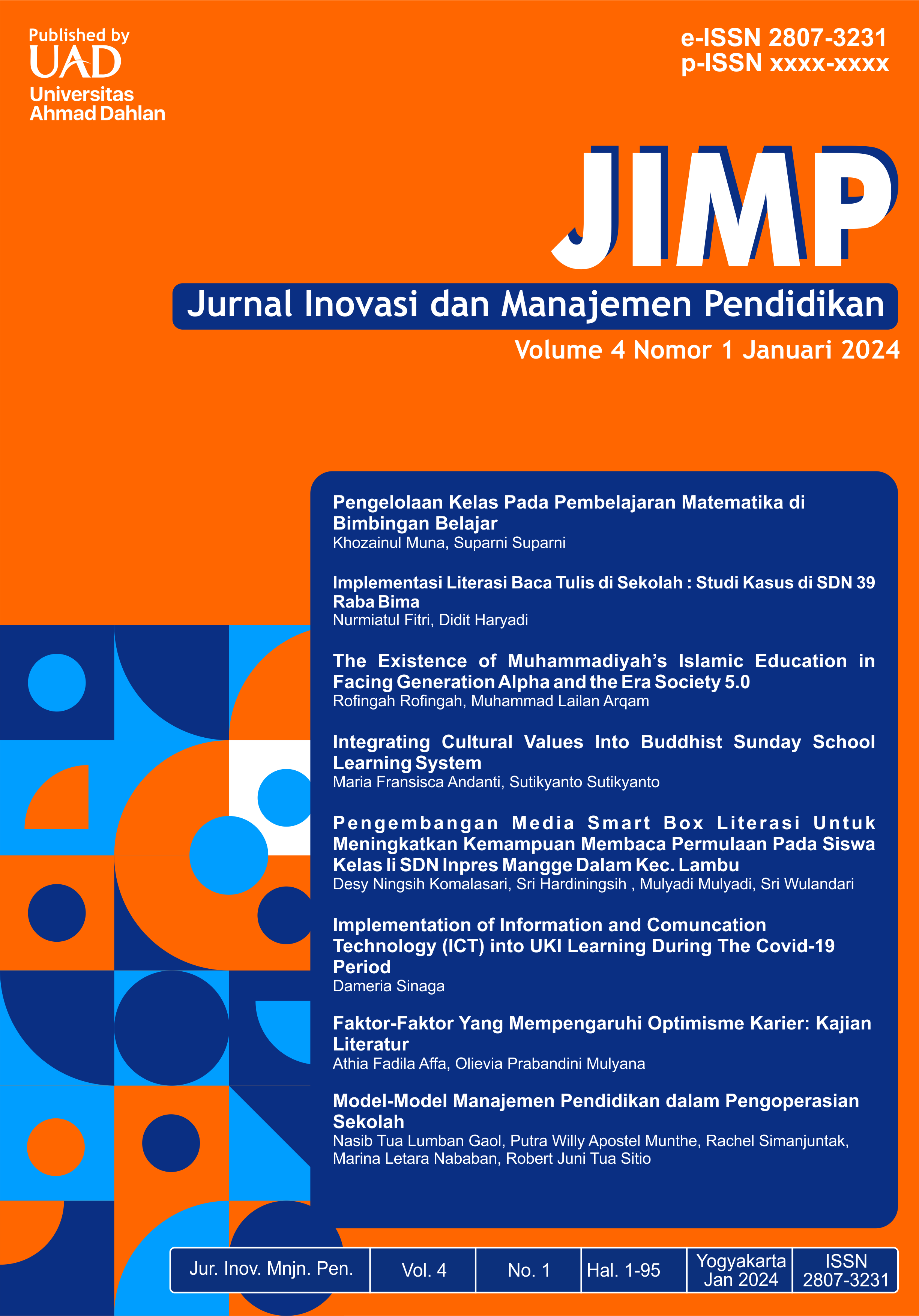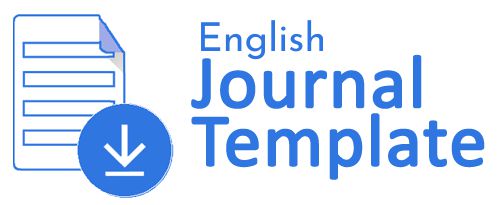The Existence of Muhammadiyah’s Islamic Education in Facing Generation Alpha and the Era Society 5.0
DOI:
https://doi.org/10.12928/jimp.v4i1.9373Keywords:
Alpha Generation, Era Society 5.0, islamic education, existenceAbstract
Generation Alpha and the era of society 5.0 are an obstacle for Muhammadiyah’s Islamic Education. Because everything is based on technology, all information is easy to get through digitally, which has positive and negative impacts. The negative effect is more dominant, so the progressivism of Muhammadiyah’s Islamic Education becomes necessary for education providers. The research aims to explore the existence of Muhammadiyah’s Islamic Education in facing the Alpha generation and the era of Society 5.0. In this study, the authors used a qualitative method of library research. Journals, articles, books, and other relevant information can support this article's data as a source.
The results showed that the existence of Muhammadiyah’s Islamic Education in the generation Alpha and the era Society 5.0 was pursued by innovating technology-based learning and lecture programs such as the eduMu, edutabMu, ISMUBAKU and SiberMu University and Trensains schools.
References
Agustang, A., Quraisy, H., Asrifan, A., & Introduction, A. (1912). Muhammadiyah Dalam Gerakan Sosial Di Kabupaten Wajo. 1–16.
Ali, M. (2016). Membedah Tujuan Pendidikan Muhammadiyah. Profetika: Jurnal Studi Islam, 17(01), 43–56. https://doi.org/10.23917/profetika.v17i01.2099
Ariyanto Muhammad, R. T. (2020). Studi evaluatif implementasi standar proses pembelajaran program keahlian teknik instalasi tenaga listrik menggunakan kurikulum 2013. Jurnal Pendidikan Teknik Elektro, 9(2), 2.
Arlini, I., & Mulyadi, A. (2022). Pemikiran K.H. Ahmad Dahlan Tentang Pendidikan Islam. Turats, 14(2), 41–70. https://doi.org/10.33558/turats.v14i2.4465
Arofah, S., & Jamu’in, M. (2015). Gagasan Dasar dan Pemikiran Pendidikan Islam K.H Ahmad Dahlan. Tajdida: Jurnal Pemikiran Dan Gerakan Muhammadiyah, 13(2), 114–124. http://journals.ums.ac.id/index.php/tajdida/article/view/1889
Bakry, M. M. (2019). Tajdid Dan Taqlid. Jurnal Al-Asas, III(33), 57–72. http://ejournal.iainpalopo.ac.id/index.php/alasas/article/view/1638
Crindle, M. (2018). Pesantren Di Antara Generasi Alfa Dan Tantangan Pendidikan di Era Revolusi Industri 4.0. 2.
Diningrum Citraningsih. (2021). Tujuan dan Manajemen Pendidikan dalam Perspektif K.H. Ahmad Dahlan. SALIHA: Jurnal Pendidikan & Agama Islam, 4(2), 171–185. https://doi.org/10.54396/saliha.v4i2.171
Erfan Gazali. (2018). Pesantren Di Antara Generasi Alfa Dan Tantangan Dunia Pendidikan Era Revolusi Industri 4.0. OASIS : Jurnal Ilmiah Kajian Islam, 2(2), 94–109.
Fadli, M., & Djollong, A. F. (2018). Konsep Pendidikan Islam Menurut KH. Ahmad Dahlan (The Concept of Islamic Education By KH. Ahmad Dahlan). Istiqra’, 5(2), 1–7. https://jurnal.umpar.ac.id/index.php/istiqra/article/view/445/370
Faruq, U. Al. (2020). Peluang Dan Tantangan Pendidikan Muhammadiyah Di Era 4.0. Ar-Risalah: Media Keislaman, Pendidikan Dan Hukum Islam, XVIII(1), 13–30.
Hafni, D. A., & Harventy, G. (2013). Membingkai Good Corporate Governance Amal Usaha Muhammadiyah dalam Kerangka Amanah. Jurnal Akuntansi & Investas, 14(2), 86–95. www.muhammadiyah.or.id
Hamzah. (1989). Pembaharuan Pendidikan dan Pengajaran Islam A Hamzah. Mulia offset.
Ibrohim, I., Mansyur, A. S., Syah, M., & Ruswandi, U. (2021). Educational Innovation in Developing Quality Management Muhammadiyah Best Elementary School Bandung. Ta Dib : Jurnal Pendidikan Islam, 10(1), 9–24. https://doi.org/10.29313/tjpi.v10i1.7003
Jakaria Umro. (2020). Tantangan Guru Pendidikan Agama Islam DalamMenghadapi Era Society 5.0. Jurnal Al-Makrifat , 5(1), 79–95. https://core.ac.uk/download/pdf/327174919.pdf
Khozin. (2016). Pengembangan Ilmu Di Perguruan Tinggi Keagamaan Islam Kontruksi Kerangka Dan Langkah-Langkahnya. Kencana Prenada Media Group.
Listiana, H. (2015). Lembaga Pendidikan Islam Akhir Abad XX Studi Pendidikan Muhammadiyah Sekolah Umum Plus dan Boarding School. TADRIS: Jurnal Pendidikan Islam, 10(2), 230. https://doi.org/10.19105/tjpi.v10i2.827
Mangifera, L., & Muzakar, I. (2017). Penguatan Kelembagaan Amal Usaha Muhammadiyah (Studi Kasus di MIM PK Wirogunan). Tarb Iyatuna, 8(2), 104–108.
Mayumi Fukuyama. (2018). Society 5.0: Aiming for a New Human-centered Society. Japan SPOTLIGHT, August, 8–13.
Muchlas, D. (2022). Dakwah Muhammadiyah Dalam Masyarakat Digital: Peluang Dan Tantangan.
Muhammadiyah, P. P. (2010). Tanfidz keputusan Muktamar Satu Abad Muhamadiyah. Tanfidz Keputusan Muktamar Satu Abad Muhammadiyah, September, 128.
Putra, P. H. (2019). Tantangan Pendidikan Islam dalam Menghadapi Society 5.0. Islamika : Jurnal Ilmu-Ilmu Keislaman, 19(02), 99–110. https://doi.org/10.32939/islamika.v19i02.458
Rahmi, I. (2019). Dinamika Historis Madrasah Muallimin UNIVA Medan (1958-2019). http://repository.uinsu.ac.id/9298/%0Ahttp://repository.uinsu.ac.id/9298/1/IHYAUR RAHMI.pdf
Septiani, D., Martini, A., & Akbar, Z. (2020). Studi Literatur Pengembangan Empati Untuk Menghadapi Masyarakat Era 5.0. JPD: Jurnal Pendidikan Dasar. http://journal.unj.ac.id/unj/index.php/psdpd/article/view/17770
Subhan, A. (2012a). Lembaga Pendidikan Islam Indonesia Abad ke-20 Pergumulan antara Modernisasi dan Identitas. Kencana Prenada Media Group.
Subhan, A. (2012b). Lembaga Pendidikan Islam Indonesia Abad ke-20 Pergumulan antara Modernisasi dan Identitas. Kencana.
Susilo, M. J. (2016). Kajian Kemandirian Sekolah di Amal Usaha Muhammadiyah. Prosiding Seminar Nasional Pendidikan Berkemanjuan Dan Menggembirakan, 625–633. https://publikasiilmiah.ums.ac.id/xmlui/handle/11617/7874
Sutiah. (2018). Pengembangan Model Pembelajaran Agama Islam. Nizamia Learning Center.
Swandhina, M. (2022). Generasi Alpha: Saatnya Anak Usia Dini Melek Digital Refleksi Proses Pembelajaran Dimasa Pandemi Covid-19. Jurnal Edukasi Sebelas April (JESA), 6(1), 150. https://ejournal.unsap.ac.id/index.php/jesa
Syamsudin. (n.d.). The Muhammadiyah Da’wah.
Terbuka, U. (2018). Peran Pustakawan Pendidikan Jarak Jauh Di Era Disrupsi: Studi Kasus Di Perpustakaan Universitas Terbuka. Jurnal Pustakawan Indonesia, 17(2).
Ula, N. (2022). Lembaga Pendidikan Islam Dan Gerakan Reformis : Muhammadiyah. 1(1), 118–129.
Wicaksono, D. S., Kasmantoni, & Walid, A. (2021). Peranan Pondok Pesantren Dalam Menghadapi Generasi Alfa dan Tantangan Dunia Pendidikan Era Society 5.0. Jurnal Pendidikan Tematik, 2(2), 181–189.
Wiryosukarto, E. (2018). Pesantren Di Antara Generasi Alfa Dan Tantangan Pendidikan di Era Revolusi Industri 4.0. OASIS: Jurnal Ilmiah Kajian Islam, 2(2).
Yogyakarta, U. N. (n.d.). Jurnal llmiah Pendidikan.
Yuliasari, P. (2014). Relevansi konsep pendidikan islam kh. ahmad dahlan di abad 21. Jurnal Studi Islam & Pendiidkan As-Salam, 5(1), 45–64.
Yusra, N. (2018). Muhammadiyah: Gerakan Pembaharuan Pendidikan Islam. POTENSIA: Jurnal Kependidikan Islam, 4(1), 103. https://doi.org/10.24014/potensia.v4i1.5269
https://umsrappang.ac.id/edutabmu-akselerasi-pendidikan-muhammadiyah-di-era-digital
https://play.google.com/store/apps/details?id=com.amd.ismubaku
Downloads
Published
How to Cite
Issue
Section
License
Copyright (c) 2024 Rofingah, Muhammad Lailan Arqam

This work is licensed under a Creative Commons Attribution-ShareAlike 4.0 International License.
This article's copyright is transferred to Universitas Ahmad Dahlan (UAD) if and when the item is accepted for publication. The undersigned hereby transfers any rights in and to the paper including without limitation all copyrights to UAD. The undersigned hereby represents and warrants that the article is original and that he/she is the author of the paper, except for material identified as to its source, with permission notices from the copyright owners where required. The undersigned represents that he/she has the power and authority to make and execute this assignment.
We declare that:
This paper has not been published in the same form elsewhere.
It will not be submitted anywhere else for publication before acceptance/rejection by this Journal.
Copyright permission is obtained for materials published elsewhere and which require this permission for reproduction.
Furthermore, I/We hereby transfer the unlimited rights of publication of the above-mentioned paper in whole to UAD. The copyright transfer covers the exclusive right to reproduce and distribute the article, including reprints, translations, photographic reproductions, microform, electronic form (offline, online), or any other reproductions of similar nature.
The corresponding author signs for and accepts responsibility for releasing this material on behalf of any co-authors. This agreement is to be signed by at least one of the authors who have obtained the co-author(s) assent where applicable. After submission of this agreement signed by the corresponding author, changes of authorship or in the order of the authors listed will not be accepted.
Retained Rights/Terms and Conditions
Authors retain all proprietary rights in any process, procedure, or article of manufacture described in the Work.
Authors may reproduce or authorize others to reproduce the Work or derivative works for the author's personal use or company use, provided that the source and the UAD copyright notice are indicated, the copies are not used in any way that implies UAD endorsement of a product or service of any employer, and the documents themselves are not offered for sale.
Although authors are permitted to re-use all or portions of the Work in other works, this does not include granting third-party requests for reprinting, republishing, or different types of re-use.







